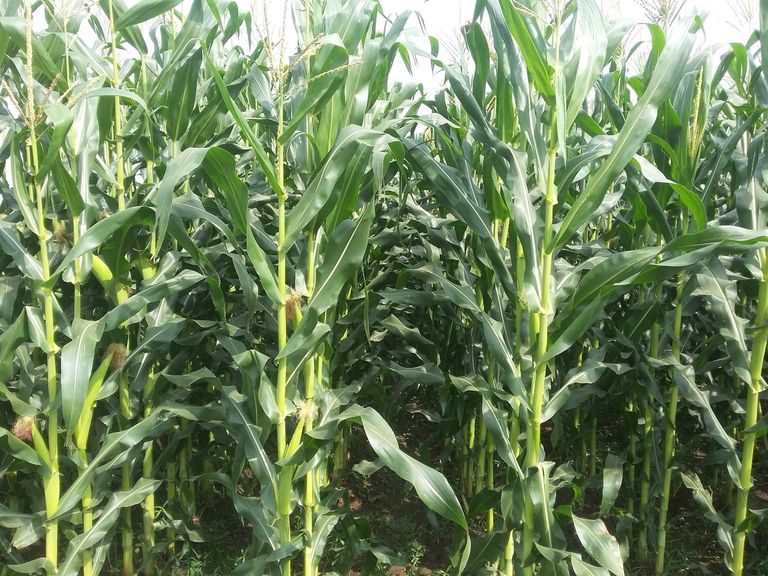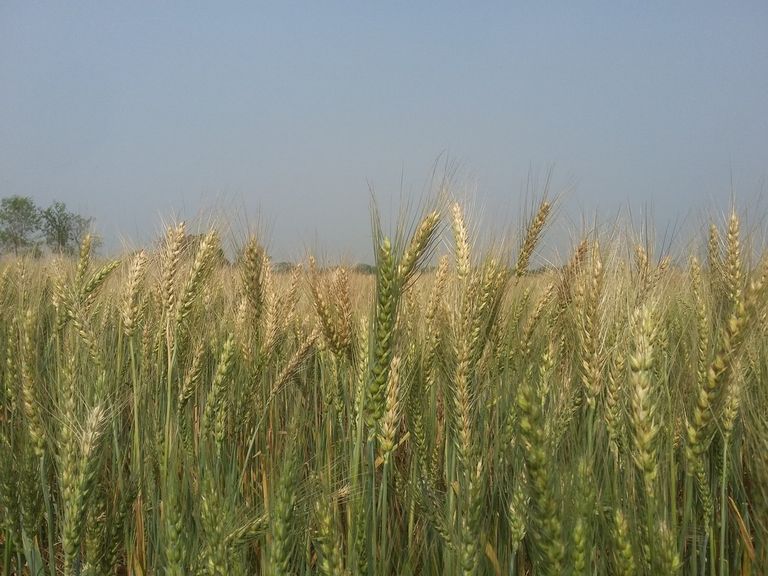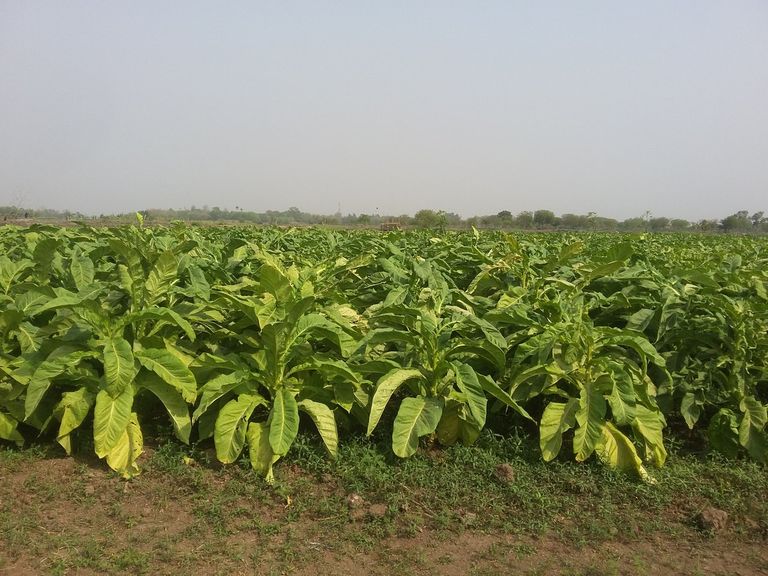
Maize, locally known as makai or corn, is an important grain in our daily diet. It is considered one of the oldest crops in the world and is widely cultivated as a food grain in our country. Maize originated in Mexico, but today it is popular and widely used around the world.
Types of corn
There are many types of corn, such as sweet corn, popcorn, grain corn, and meal corn. Our country mainly cultivates grain maize, which is used as food grain and animal feed. Sweet corn is popular for eating straight away, as it is sweet and juicy. The variety named Popcorn is specially developed which swells in the heat and is made into popcorn.
Nutritional value
Corn is full of nutrients. It contains carbohydrates, protein, fiber, vitamins A, B, E and various minerals. Eating corn gives energy to our body and improves digestion. The fiber present in it is beneficial for the body and it helps in relieving constipation. The presence of vitamin A in corn is especially beneficial for eye health. Besides, it contains antioxidants that boost our immune system. Corn is also a good food for those who want to lose weight, as it keeps the stomach full for a long time.
Maize Cultivation
Maize is a drought tolerant crop and can be easily cultivated in different regions of Bangladesh. Summer and rainy season are the ideal time for maize. This crop needs lots of sun, fertile soil, and the right amount of water. At present, farmers are getting good yields by using improved varieties of maize seeds in the country. Maize cultivation is increasing in Bangladesh and it is being used as an alternative crop to rice and wheat. In particular, corn is a major ingredient in poultry and fish feed. Flour is made from corn flour, which is used in various food preparations.
Maize's versatile uses set it apart from other grains. Corn can be boiled directly and eaten or used as an ingredient in various dishes. Cornmeal breads, puddings, soups, salads, and popcorn are popular foods. In addition, corn also produces oil, flour, and syrup that are used in various foods. Corn also plays an important role as animal feed. It is used as a major feed ingredient for poultry and cattle. Biofuels made from corn are also being used as an environmentally friendly energy source, which can help solve energy problems.
ভুট্টা, যা আমরা স্থানীয়ভাবে মকাই বা কর্ন নামে চিনি, আমাদের দৈনন্দিন খাদ্যাভ্যাসের একটি গুরুত্বপূর্ণ শস্য। এটি বিশ্বের অন্যতম প্রাচীন শস্য হিসেবে বিবেচিত এবং আমাদের দেশে খাদ্যশস্য হিসেবে ব্যাপকভাবে চাষ হয়। ভুট্টার উৎপত্তি মেক্সিকোতে, তবে আজ তা বিশ্বজুড়ে জনপ্রিয় এবং ব্যাপকভাবে ব্যবহৃত হয়।
ভুট্টার প্রকারভেদ
ভুট্টার অনেক প্রকার রয়েছে, যেমন মিষ্টি ভুট্টা, পপকর্ন, দানাদার ভুট্টা এবং খাবার ভুট্টা। আমাদের দেশে প্রধানত দানাদার ভুট্টার চাষ হয়, যা খাদ্যশস্য ও পশুখাদ্য হিসেবে ব্যবহৃত হয়। মিষ্টি ভুট্টা সরাসরি খাওয়ার জন্য জনপ্রিয়, কারণ এটি মিষ্টি ও রসালো হয়। পপকর্ন নামের প্রকারটি বিশেষভাবে তৈরি হয় যা গরমে ফুলে ওঠে এবং পপকর্ন তৈরি করা হয়।
পুষ্টিগুণ
ভুট্টা পুষ্টিগুণে ভরপুর। এতে রয়েছে শর্করা, প্রোটিন, আঁশ, ভিটামিন এ, বি, ই এবং বিভিন্ন খনিজ পদার্থ। ভুট্টা খাওয়া আমাদের শরীরের শক্তি যোগায় এবং হজম শক্তি বাড়ায়। এতে উপস্থিত আঁশ শরীরের জন্য উপকারী এবং এটি কোষ্ঠকাঠিন্য দূর করতে সাহায্য করে।ভুট্টায় ভিটামিন এ এর উপস্থিতি চোখের স্বাস্থ্যের জন্য বিশেষভাবে উপকারী। এছাড়া, এতে পাওয়া যায় অ্যান্টিঅক্সিডেন্ট যা আমাদের রোগ প্রতিরোধ ক্ষমতা বৃদ্ধি করে। যারা ওজন কমাতে চান, তাদের জন্যও ভুট্টা একটি ভালো খাবার, কারণ এটি দীর্ঘ সময় পেট ভর্তি রাখে।
ভুট্টার চাষাবাদ
ভুট্টা একটি খরা সহনশীল ফসল এবং বাংলাদেশের বিভিন্ন অঞ্চলে সহজেই চাষ করা যায়। গ্রীষ্মকাল এবং বর্ষাকাল ভুট্টার জন্য আদর্শ সময়। এ ফসলের জন্য প্রচুর রোদ, উর্বর মাটি, এবং সঠিক মাত্রার পানি প্রয়োজন হয়। বর্তমানে দেশে উন্নত প্রজাতির ভুট্টা বীজ ব্যবহার করে চাষিরা ভালো ফলন পাচ্ছেন।বাংলাদেশে ভুট্টার চাষ বাড়ছে এবং এটি ধান ও গমের বিকল্প শস্য হিসেবে ব্যবহৃত হচ্ছে। বিশেষত, মুরগি ও মাছের খাবার তৈরিতে ভুট্টা একটি প্রধান উপাদান। ভুট্টার গুঁড়ো থেকে ময়দা তৈরি করা হয়, যা বিভিন্ন খাদ্য প্রস্তুতিতে ব্যবহৃত হয়।
ভুট্টার বহুমুখী ব্যবহার একে অন্যান্য শস্য থেকে আলাদা করেছে। ভুট্টা সরাসরি সিদ্ধ করে খাওয়া যায় বা বিভিন্ন খাবারের উপকরণ হিসেবে ব্যবহার করা যায়। ভুট্টার আটার রুটি, পুডিং, সুপ, সালাদ, এবং পপকর্ন জনপ্রিয় খাবার। এছাড়াও, ভুট্টার তেল, ময়দা, এবং সিরাপও তৈরি হয় যা বিভিন্ন খাবারে ব্যবহৃত হয়।পশুখাদ্য হিসেবেও ভুট্টা একটি গুরুত্বপূর্ণ ভূমিকা পালন করে। মুরগি ও গবাদিপশুর জন্য এটি প্রধান খাদ্য উপাদান হিসেবে ব্যবহৃত হয়। ভুট্টা থেকে প্রস্তুত বায়োফুয়েলও পরিবেশবান্ধব শক্তির উৎস হিসেবে ব্যবহৃত হচ্ছে, যা জ্বালানি সমস্যা সমাধানে সহায়ক হতে পারে।

Wheat is one of the major crops of the world and its importance as a food grain is immense. Along with rice and maize, wheat also occupies an important place in the human diet. In various countries of the world, especially in South Asia, wheat is the daily food of billions of people. Food products such as wheat flour, flour, semolina etc. are widely used in daily life.
The origin of wheat and the cultivation of wheat originated in the Middle East in ancient times. Historically, wheat was an important crop in the Mesopotamian and Egyptian civilizations. Currently wheat cultivation is widespread worldwide, and it produces good yields mainly in temperate regions. Wheat is also grown as a winter crop in Bangladesh. Wheat cultivation requires fertile soil and a balanced climate. It is mainly cultivated during the Rabi season, when the soil is dry and the temperature is between 10 and 25 degrees Celsius. Northern districts such as Dinajpur, Rangpur, and Rajshahi areas are suitable for wheat cultivation in Bangladesh.
Nutrients include plenty of carbohydrates, protein, fiber, B vitamins, and minerals. It is highly nutritious and a good source of energy for our body. The protein in wheat flour is helpful in the formation of cells in our body and it helps in strengthening the muscles. The fiber in wheat relieves constipation and aids in digestion. Eating wheat regularly reduces cholesterol levels in the body and reduces the risk of heart disease. Besides, vitamin B and E in wheat are also beneficial for our skin, hair and nails.
Various types of food products are made from wheat. From flour and dough we make bread, paratha, pita, pasta, noodles, biscuits etc. Breads and pastries made from wheat flour are popular all over the world. Apart from this, wheat semolina and semolina are used to prepare many types of sweets and dishes. The versatile use of wheat is not limited to food. Wheat also has industrial uses. Wheat husk and husk are used as fodder. Besides, gluten is produced from wheat which is used in food processing. Wheat germ oil is also used in the cosmetic and pharmaceutical industries.
Wheat Cultivation in Bangladesh Although wheat cultivation in Bangladesh is somewhat less than that of rice and maize, it is becoming increasingly popular. Wheat cultivation is being improved through various initiatives of the government and agriculture department through improved seeds, irrigation systems, and training. However, there are some challenges in wheat cultivation. For example, erratic weather, disease and insect infestation and lack of adequate irrigation. However, these problems can be solved with proper care and use of advanced agricultural technology.
Wheat is not only a food grain but also important for the country's economy. Wheat produced in the country is contributing to the economy in addition to meeting the domestic demand of the country, in some cases through exports. Besides, food products produced from wheat are in huge demand in the country and abroad.
গম হলো পৃথিবীর অন্যতম প্রধান শস্য এবং খাদ্যশস্য হিসেবে এর গুরুত্ব অপরিসীম। ধান ও ভুট্টার পাশাপাশি গমও মানুষের খাদ্য তালিকায় একটি গুরুত্বপূর্ণ স্থান অধিকার করে আছে। বিশ্বের বিভিন্ন দেশে, বিশেষ করে দক্ষিণ এশিয়ায়, গমের ওপর নির্ভর করে কোটি কোটি মানুষের দৈনন্দিন খাদ্য। গম থেকে প্রাপ্ত আটা, ময়দা, সুজি ইত্যাদি খাদ্যপণ্য দৈনন্দিন জীবনে বহুল ব্যবহৃত।
গমের উৎপত্তি ও চাষগমের উৎপত্তি প্রাচীনকালে মধ্যপ্রাচ্যে হয়েছিল। ইতিহাসে দেখা যায়, মেসোপটেমিয়া এবং মিশরীয় সভ্যতায় গম ছিল একটি গুরুত্বপূর্ণ ফসল। বর্তমান সময়ে গমের চাষ বিশ্বব্যাপী বিস্তৃত, এবং এটি প্রধানত শীতপ্রধান অঞ্চলে ভালো ফলন দেয়। বাংলাদেশেও শীতকালীন ফসল হিসেবে গমের চাষ হয়ে থাকে।গমের চাষের জন্য প্রয়োজন উর্বর মাটি এবং সুষম জলবায়ু। এটি প্রধানত রবি মৌসুমে চাষ করা হয়, যখন মাটি শুষ্ক থাকে এবং তাপমাত্রা ১০ থেকে ২৫ ডিগ্রি সেলসিয়াসের মধ্যে থাকে। বাংলাদেশে গম চাষের জন্য উত্তরের জেলা যেমন দিনাজপুর, রংপুর, এবং রাজশাহী এলাকাগুলো উপযুক্ত।
পুষ্টিগুণগমের মধ্যে রয়েছে প্রচুর পরিমাণে শর্করা, প্রোটিন, ফাইবার, ভিটামিন বি, এবং খনিজ পদার্থ। এটি আমাদের শরীরের জন্য অত্যন্ত পুষ্টিকর এবং শক্তির একটি ভালো উৎস। গমের আটাতে থাকা প্রোটিন আমাদের শরীরের কোষ গঠনে সহায়ক এবং এটি মাংসপেশি মজবুত করতে সাহায্য করে।গমে থাকা আঁশ কোষ্ঠকাঠিন্য দূর করে এবং হজমে সহায়তা করে। নিয়মিত গম খেলে শরীরে কোলেস্টেরলের মাত্রা কমে এবং হৃদরোগের ঝুঁকি হ্রাস পায়। এছাড়া গমে থাকা ভিটামিন বি এবং ই আমাদের ত্বক, চুল এবং নখের জন্যও উপকারী।
গম থেকে তৈরি হয় নানা ধরনের খাদ্যপণ্য। আটা এবং ময়দা থেকে আমরা রুটি, পরোটা, পিঠা, পাস্তা, নুডলস, বিস্কুট ইত্যাদি তৈরি করি। গমের ময়দা থেকে বানানো ব্রেড এবং পেস্ট্রি সারাবিশ্বে জনপ্রিয়। এছাড়া গমের সুজি এবং সেমোলিনা অনেক ধরনের মিষ্টি ও খাবার তৈরিতে ব্যবহৃত হয়।গমের বহুমুখী ব্যবহার শুধুমাত্র খাদ্যের মধ্যে সীমাবদ্ধ নয়। শিল্প খাতেও গমের ব্যবহার রয়েছে। গমের ভূষি এবং খোসা পশুখাদ্য হিসেবে ব্যবহৃত হয়। এছাড়া, গম থেকে তৈরি হয় গ্লুটেন যা খাদ্য প্রক্রিয়াকরণে ব্যবহৃত হয়। গমের তেলও ব্যবহার করা হয় প্রসাধনী এবং ফার্মাসিউটিক্যাল শিল্পে।
বাংলাদেশের গম চাষাবাদবাংলাদেশে গমের চাষ ধান ও ভুট্টার তুলনায় কিছুটা কম হলেও, এটি ক্রমশ জনপ্রিয় হয়ে উঠছে। সরকার এবং কৃষি বিভাগের বিভিন্ন উদ্যোগের মাধ্যমে উন্নত বীজ, সেচ ব্যবস্থা, এবং প্রশিক্ষণ প্রদানের মাধ্যমে গম চাষের উন্নতি করা হচ্ছে।তবে গম চাষে কিছু চ্যালেঞ্জও রয়েছে। যেমন, অনিয়মিত আবহাওয়া, রোগ ও পোকার আক্রমণ এবং পর্যাপ্ত সেচের অভাব। তবে সঠিক যত্ন এবং উন্নত কৃষি প্রযুক্তি ব্যবহারের মাধ্যমে এই সমস্যাগুলো সমাধান করা সম্ভব।
গম শুধু খাদ্যশস্য নয়, এটি দেশের অর্থনীতির জন্যও গুরুত্বপূর্ণ। দেশে উৎপাদিত গম দেশের অভ্যন্তরীণ চাহিদা মেটানোর পাশাপাশি, কিছু ক্ষেত্রে রপ্তানির মাধ্যমেও অর্থনীতিতে অবদান রাখছে। এছাড়া, গম থেকে উৎপাদিত খাদ্যপণ্য দেশে ও বিদেশে বিপুল চাহিদা রয়েছে।

Tobacco, which is used to make cigarettes, bidis, and other smoking materials, has influenced human life since ancient times. Although tobacco use originated primarily among indigenous populations in South and Central America, today it is a controversial and widely used product around the world. The effects of tobacco are not only harmful to human health, but also have a negative impact on the economy and the environment.
History of tobacco
Tobacco cultivation began about 6,000 years ago with Native American peoples. When European explorers reached the Americas, they were introduced to tobacco and gradually it spread to Europe and Asia. Today, tobacco cultivation is widespread in many countries of the world and has established itself as a large industry.
Tobacco Cultivation and Economics
Tobacco is an economically important crop worldwide. Tobacco cultivation is a major economic activity in many developing countries, including Bangladesh. Tobacco cultivation is extensive in Kushtia, Rajshahi, and Gaibandha regions of Bangladesh. Farmers in the country earn their livelihood by growing tobacco and exporting it has become an important source of foreign exchange for the country. However, there are some negative aspects associated with tobacco farming. Cultivation of tobacco requires large amounts of land and irrigation, which could be used for cultivation of other food crops. Besides, tobacco cultivation has a negative impact on the soil and environment. Soil fertility is reduced and large amounts of chemical fertilizers and pesticides are used, leading to environmental pollution.
Health risks of tobacco
The biggest problem with tobacco is the health risks associated with its use. Nicotine and other toxic chemicals present in tobacco have direct harmful effects on the human body. Smoking increases the risk of serious diseases like lung, heart and cancer. Cigarette or bidi smoking is considered to be the cause of lung cancer, heart disease, stroke and other complex diseases. Not only the smoker, but also those around who inhale the secondhand smoke are at health risk. The government has enacted various laws to prevent smoking-related diseases, but due to lack of awareness, many people are still unable to stop using tobacco.
Environmental impact
Tobacco cultivation and the production of tobacco products also have a negative impact on the environment. Forests are constantly being cleared for tobacco cultivation, which increases atmospheric carbon dioxide levels. Moreover, chemicals used in tobacco processing and cigarette manufacturing are polluting the environment. Smoke emitted by smoking is one of the causes of air pollution, which is harmful not only to humans but also to animals and plants.
Many initiatives have been taken to reduce tobacco use around the world. Various tobacco control legislations and awareness campaigns are being conducted under the leadership of the World Health Organization. Bangladesh also has strict tobacco control laws, such as banning smoking, placing warning labels on packets, and banning advertising of tobacco products.
তামাক, যা সিগারেট, বিড়ি, এবং অন্যান্য ধূমপানের সামগ্রী তৈরির জন্য ব্যবহৃত হয়, প্রাচীনকাল থেকে মানুষের জীবনে প্রভাব ফেলেছে। যদিও তামাকের ব্যবহার মূলত দক্ষিণ ও মধ্য আমেরিকার স্থানীয় জনগোষ্ঠীর মধ্যে শুরু হয়েছিল, বর্তমানে এটি বিশ্বজুড়ে একটি বিতর্কিত ও বহুল ব্যবহৃত পণ্য। তামাকের প্রভাব শুধু মানুষের স্বাস্থ্যের জন্য ক্ষতিকর নয়, বরং এটি অর্থনীতি এবং পরিবেশের ওপরও নেতিবাচক প্রভাব ফেলে।
তামাকের ইতিহাস
তামাকের চাষ প্রায় ৬,০০০ বছর আগে আমেরিকার স্থানীয় জনগোষ্ঠীর মাধ্যমে শুরু হয়েছিল। ইউরোপীয় অভিযাত্রীরা যখন আমেরিকা মহাদেশে পৌঁছায়, তখন তারা তামাকের সঙ্গে পরিচিত হয় এবং ধীরে ধীরে এটি ইউরোপ এবং এশিয়ায় ছড়িয়ে পড়ে। বর্তমানে তামাক চাষ পৃথিবীর বিভিন্ন দেশে ব্যাপকভাবে হয় এবং এটি একটি বৃহৎ শিল্প হিসেবে প্রতিষ্ঠিত হয়েছে।
তামাক চাষ ও অর্থনীতি
বিশ্বজুড়ে তামাক একটি অর্থনৈতিকভাবে গুরুত্বপূর্ণ ফসল। বাংলাদেশসহ অনেক উন্নয়নশীল দেশে তামাক চাষ একটি প্রধান অর্থনৈতিক কর্মকাণ্ড। বাংলাদেশের কুষ্টিয়া, রাজশাহী, এবং গাইবান্ধা অঞ্চলে তামাক চাষ ব্যাপকভাবে হয়। দেশের কৃষকেরা তামাক চাষের মাধ্যমে জীবিকা নির্বাহ করেন এবং এটি রপ্তানি করে দেশের বৈদেশিক মুদ্রা অর্জনের একটি গুরুত্বপূর্ণ উৎস হয়ে উঠেছে।তবে তামাক চাষের সঙ্গে যুক্ত কিছু নেতিবাচক দিকও রয়েছে। তামাক চাষের জন্য প্রচুর পরিমাণ জমি এবং সেচের প্রয়োজন হয়, যা অন্যান্য খাদ্যশস্যের চাষের জন্য ব্যবহার করা যেত। এছাড়া তামাক চাষের ফলে মাটি এবং পরিবেশের উপর নেতিবাচক প্রভাব পড়ে। মাটির উর্বরতা হ্রাস পায় এবং প্রচুর পরিমাণে রাসায়নিক সার ও কীটনাশক ব্যবহৃত হয়, যা পরিবেশ দূষণের কারণ হয়ে দাঁড়ায়।
তামাকের স্বাস্থ্যঝুঁকি
তামাকের সবচেয়ে বড় সমস্যা হলো এর ব্যবহারজনিত স্বাস্থ্যঝুঁকি। তামাকের মধ্যে থাকা নিকোটিন এবং অন্যান্য বিষাক্ত রাসায়নিক পদার্থগুলি সরাসরি মানবদেহে ক্ষতিকর প্রভাব ফেলে। ধূমপান ফুসফুস, হৃদযন্ত্র এবং ক্যান্সারের মতো মারাত্মক রোগের ঝুঁকি বাড়ায়। সিগারেট বা বিড়ি ধূমপান ফুসফুসের ক্যান্সার, হৃদরোগ, স্ট্রোক এবং অন্যান্য জটিল রোগের কারণ হিসেবে বিবেচিত হয়।শুধু ধূমপায়ী ব্যক্তিরাই নয়, আশেপাশের যারা ধূমপানের ধোঁয়া গ্রহণ করে, তারাও স্বাস্থ্যঝুঁকির মধ্যে থাকে। ধূমপানজনিত রোগ প্রতিরোধে সরকার বিভিন্ন আইন প্রণয়ন করেছে, তবে সচেতনতার অভাবে অনেক মানুষ এখনও তামাকের ব্যবহার বন্ধ করতে পারছে না।
পরিবেশগত প্রভাব
তামাক চাষ এবং তামাকজাত পণ্য উৎপাদন পরিবেশের উপরেও নেতিবাচক প্রভাব ফেলে। তামাক চাষের জন্য প্রতিনিয়ত বনভূমি কেটে ফেলা হচ্ছে, যা বায়ুমণ্ডলীয় কার্বন ডাই অক্সাইডের মাত্রা বাড়াচ্ছে। তাছাড়া, তামাক প্রক্রিয়াকরণ এবং সিগারেট উৎপাদনে ব্যবহৃত রাসায়নিক পদার্থ পরিবেশ দূষণ করছে। ধূমপানের ফলে নির্গত ধোঁয়া বায়ু দূষণের অন্যতম কারণ, যা শুধু মানুষের জন্য নয়, প্রাণী ও উদ্ভিদের জন্যও ক্ষতিকর।
বিশ্বজুড়ে তামাকের ব্যবহার কমানোর জন্য অনেক উদ্যোগ নেওয়া হয়েছে। বিশ্ব স্বাস্থ্য সংস্থা এর নেতৃত্বে তামাক নিয়ন্ত্রণে বিভিন্ন আইন প্রণয়ন এবং সচেতনতামূলক প্রচার চালানো হচ্ছে। বাংলাদেশেও তামাক নিয়ন্ত্রণে কঠোর আইন রয়েছে, যেমন ধূমপান নিষিদ্ধ করা, প্যাকেটের উপর সতর্কীকরণ লেবেল দেওয়া এবং তামাকজাত পণ্যের বিজ্ঞাপন নিষিদ্ধ করা।